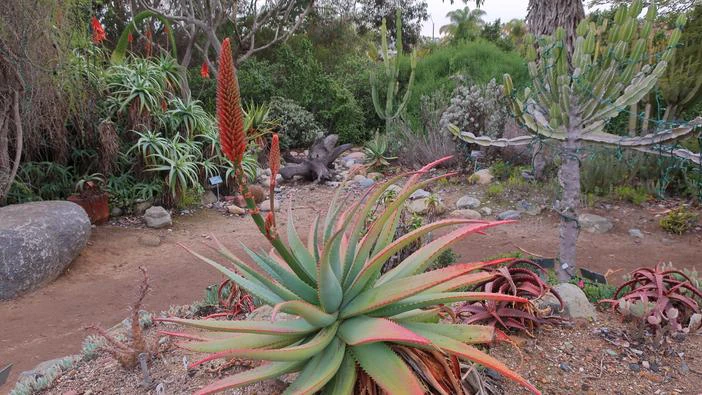Tilt-Head Aloe
(Aloe speciosa)
Tilt-Head Aloe (Aloe speciosa)
/
/

cultivar413
CC BY 2.0
Image By:
cultivar413
Recorded By:
Copyright:
CC BY 2.0
Copyright Notice:
Photo by: cultivar413 | License Type: CC BY 2.0 | License URL: https://creativecommons.org/licenses/by/2.0 | Uploader: Ser Amantio di Nicolao | Publisher: Wikipedia Commons




























Estimated Native Range
Climate Requirements for Loma Linda, California
| This Plant | Your Site | Plant Suitability for Your Location | ||
|---|---|---|---|---|
| • Precipitation | 9" - 33" | 13" | Your precipitation may be insufficient for this plant. Irrigate N" / year. | Irrigate N" / year |
| • High Temp. | 70°F - 90°F | 95°F | Your summers may be too hot for this plant. | Too hot |
| • Low Temp. | 33°F - 51°F | 40°F | Your winter temperatures are normal for this plant | Excellent |
This plant should grow well at your location with about N inches per year (Y minutes per month) of irrigation.
Summary
Aloe speciosa, commonly known as Tilt-head Aloe, is an evergreen succulent native to the Eastern Cape Province of South Africa, where it thrives in semi-arid, rocky areas and scrubland. This species typically reaches a height of 15-18 feet (4.5-5.5 meters) and a width of 8-12 feet (2.4-3.7 meters). The Tilt-head Aloe is characterized by its distinctive rosette of blue-green leaves that tilt towards the direction of the most intense sunlight, often acting as a natural compass by leaning northward. During the spring and winter, it produces dense, showy spikes of tubular orange and red flowers, which are highly attractive to birds and pollinators.
The Tilt-head Aloe is valued for its architectural form and striking flowers, making it a focal point in xeriscapes, rock gardens, and as a specimen plant in drought-tolerant landscapes. It is well-suited to cultivation in arid and semi-arid regions, requiring minimal maintenance and water once established. The plant prefers full sun exposure and well-draining soil, and it is tolerant of poor soil conditions. While generally disease-resistant, it can be susceptible to root rot if overwatered or planted in poorly draining soils. Due to its size and potential for large root systems, it should be given ample space to grow without impeding structures or other plants.CC BY-SA 4.0
The Tilt-head Aloe is valued for its architectural form and striking flowers, making it a focal point in xeriscapes, rock gardens, and as a specimen plant in drought-tolerant landscapes. It is well-suited to cultivation in arid and semi-arid regions, requiring minimal maintenance and water once established. The plant prefers full sun exposure and well-draining soil, and it is tolerant of poor soil conditions. While generally disease-resistant, it can be susceptible to root rot if overwatered or planted in poorly draining soils. Due to its size and potential for large root systems, it should be given ample space to grow without impeding structures or other plants.CC BY-SA 4.0
Plant Description
- Plant Type: Succulent
- Height: 15-18 feet
- Width: 8-12 feet
- Growth Rate: Moderate
- Flower Color: Orange, Red
- Flowering Season: Spring, Winter
- Leaf Retention: Evergreen
Growth Requirements
- Sun: Full Sun
- Water: Very Low, Low
- Drainage: Fast
Common Uses
Bee Garden, Bird Garden, Butterfly Garden, Drought Tolerant, Fire Resistant, Hummingbird Garden, Low Maintenance, Rabbit Resistant, Showy Flowers
Natural Habitat
Semi-arid, rocky areas and scrubland of the Eastern Cape Province of South Africa
Other Names
Common Names:
Scientific Names: Aloe speciosa
GBIF Accepted Name: Aloe speciosa Baker